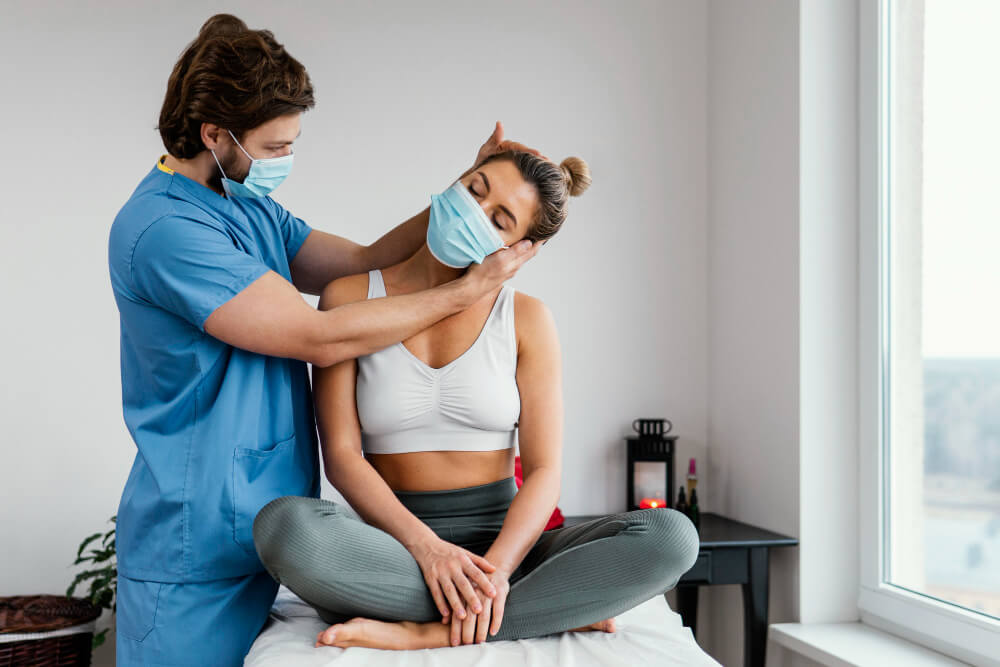Spondylosis of the Cervical Spine: Understanding the Pain and Finding Relief
What is Spondylosis?
Spondylosis, also known as osteoarthritis of the spine, is a degenerative condition that affects the joints and discs in the spine. While it can occur in any part of the spine, cervical spondylosis specifically targets the seven vertebrae and discs in the neck. This wear-and-tear process leads to bone spurs, inflammation, and narrowing of the spinal canal, which can put pressure on nerves and cause pain, stiffness, and other debilitating symptoms.
Causes and Risk Factors:
Several factors can contribute to the development of cervical spondylosis:
- Age: As we age, the discs in our spine naturally lose moisture and elasticity, making them more susceptible to wear and tear.
- Repetitive strain: Jobs or activities that involve repetitive neck movements, such as driving, computer work, or heavy lifting, can put stress on the cervical spine.
- Genetics: Some people have a genetic predisposition to developing joint problems, including spondylosis.
- Previous injuries: Whiplash or other neck injuries can damage the discs and joints, increasing the risk of spondylosis later in life.
- Obesity: Carrying excess weight puts additional strain on the spine, including the cervical region.
Symptoms of Cervical Spondylosis:
The symptoms of cervical spondylosis can vary depending on the severity of the condition and the specific nerves affected. Common symptoms include:
- Neck pain and stiffness, especially in the morning or after periods of inactivity
- Reduced range of motion in the neck
- Headaches
- Numbness, tingling, or weakness in the arms and hands
- Dizziness
- Difficulty swallowing
Diagnosis and Evaluation:
If you are experiencing symptoms of cervical spondylosis, it is important to consult a doctor for a proper diagnosis. The doctor will likely perform a physical examination and ask about your medical history. They may also order additional tests, such as X-rays, MRIs, or CT scans, to get a more detailed picture of the condition.
Treatment Options for Cervical Spondylosis:
There is no cure for cervical spondylosis, but there are many treatment options available to manage the symptoms and prevent further progression of the condition. The best treatment approach will depend on the severity of your symptoms and your overall health.
Non-surgical Treatment Options:
- Lifestyle modifications: This includes avoiding activities that aggravate your symptoms, maintaining good posture, and losing weight if necessary.
- Pain relievers: Over-the-counter pain relievers, such as ibuprofen or acetaminophen, can help manage pain and inflammation.
- Physical therapy: Physical therapy can help improve flexibility, range of motion, and strength in the neck and shoulder muscles.
- Ice and heat therapy: Applying ice packs or heat compresses to the affected area can help reduce pain and inflammation.
- Cervical collars: A soft collar can provide temporary support and reduce neck pain.
- Steroid injections: Injections of corticosteroids into the affected joints can provide temporary pain relief.
- Alternative therapies: Some people find relief with acupuncture, massage therapy, or other alternative therapies.
Surgical Treatment Options:
In some cases, surgery may be necessary if conservative treatments fail to provide adequate relief or if there is nerve damage. The most common surgical procedures for cervical spondylosis include:
- Cervical discectomy and fusion: This procedure removes a damaged disc and fuses the adjacent vertebrae together.
- Laminectomy and fusion: This procedure removes part of the bony lamina (the roof of the spinal canal) to relieve pressure on the spinal cord.
- Artificial disc replacement: This procedure replaces a damaged disc with an artificial one.
Prognosis and Prevention:
The prognosis for cervical spondylosis is generally good. Most people can manage their symptoms effectively with non-surgical treatments. However, the condition can be progressive, so it is important to see a doctor for regular follow-up appointments.
Tips for Preventing Cervical Spondylosis:
- Maintain good posture: This includes sitting up straight, avoiding hunching, and keeping your shoulders relaxed.
- Exercise regularly: Regular exercise, especially activities that strengthen the neck and shoulder muscles, can help prevent spondylosis.
- Maintain a healthy weight: Excess weight puts additional strain on the spine, so maintaining
- Spondylosis of the Cervical Spine: Decoding the Pain and Unveiling Relief


